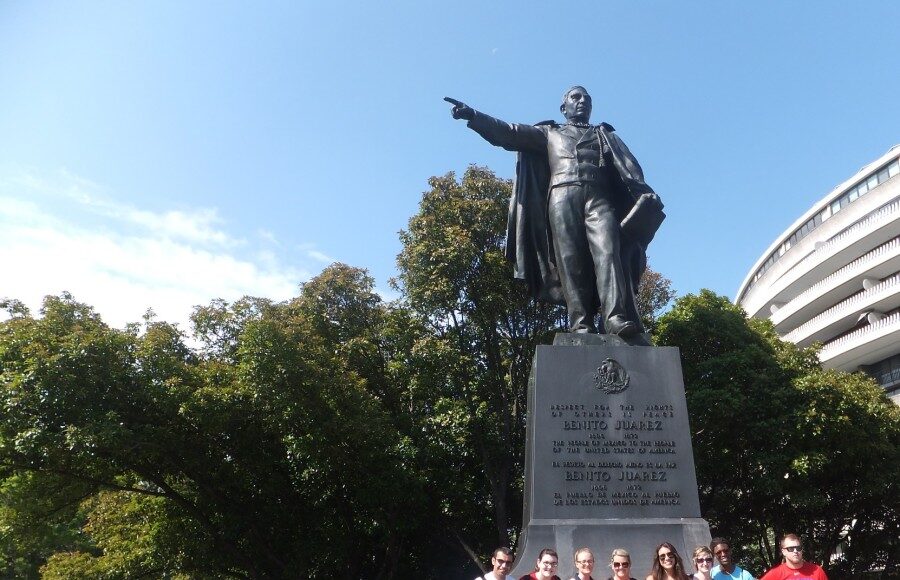Fate has a curious way of intervening in one’s life.
Two years ago I decided to leave the Middle East for the United States as a student. The decision to come to Louisiana was spurred by my admiration for the Great Emancipator and the fact that the International Lincoln Center at LSUS also serves as the headquarters of the Association of Third World Studies. Having completed my first year in Shreveport, I’m now participating on the LSUS “campus” in Washington, DC during its annual mid-May three-week Washington “semester.” In essence, it’s an experiential education in the liberal arts. The Old World meets the New World through the humanities and sciences.
Rather than a typical classroom, it’s a moving cultural feast.
Though I’m only in the middle of the semester, the first week has illustrated the program’s vibrant nature. On the first day, we began with a Beethoven concert at the National Museum of American Art, just a few blocks from the National Mall and our hotel. Later in the afternoon we walked through “monumental Washington” most familiar to typical tourists: the National Mall, Washington Monument, Constitutional Gardens, the Reflecting Pool, and the Lincoln Memorial. The visuals of democratic government are stunning. On the walk back to our hotel we visited the Einstein Memorial and saw the Old National Observatory (not the “new” Naval Observatory where the vice president resides nearby) that made the Old World take note (after Benjamin Franklin’s initial splash) that the New World might be a serious experiment.
On the second day we retreated “inside” Washington to the art and politics of its cultural and political institutions. The morning began with a tour of the Kennedy Center with its huge concert halls and theaters which brings musicians, dancers, and others from around the world. Later in the day we were the only student group attending a program of the American Enterprise Institute which featured Dr. Lynne Cheney discussing her new biography of James Madison. Several of us had her sign our copies of it. A twist in the program was that she was interviewed about the biography by her spouse, the former vice president. I had my photo taken with him as a memento from the occasion.
The third day brought science and history together with a lecture by the author of a new biography of Clara Barton, founder of the American Red Cross, who knew Abraham Lincoln during the Civil War. It was held at the National Archives. After an evening meal with former alumni from the 31 years old Washington program, we attended a lecture on the Skylab at the Air and Space Museum. Lincoln had once viewed the heavens through the largest telescope in the world at the Old Naval Observatory located near the White House.
On the fourth day we began our walking tour with a visit to one of the boarding houses where John Marshall, the greatest justice of the Supreme Court (1801-1835) once lived. This was on the way to tour the Diplomatic Reception rooms of the State Department. From the outside it looks like just another bureaucratic building, but the eighth floor replicates rooms from the late 18th century. It houses the third greatest Americana collection in the country. The largest room named for Benjamin Franklin, the father of the diplomatic corps, is used by the secretary of state to host large dinners with 300 guests.
On the way back, we stopped next to Lafayette Park, where Henry Adams – presidential grandson, turned historian – lived. His novel Democracy, available online, depicts what became cycles of corruption in the nation’s capital (Credit Mobilier, Teapot Dome, Watergate, etc.). The “Southern Belle” in the novel came to DC wanting to know the essence of democratic politics. She chose to return the South once she learned its darker side. In the evening, we heard historian Nigel Hamilton discuss his new book on FDR, Mantle of Command, which depicts the president as the nation’s greatest “commander-in-chief” despite Winston Churchill’s biased views. Hamilton thinks that FDR had a larger strategic wisdom of the world than his military commanders, as well as a broader vision of the world than other political leaders. Unlike Churchill, FDR understood colonialism and empires were passé.
The fifth day began with a tour of “The Castle” on the National Mall—the first Smithsonian building. As the oldest part of the Smithsonian, it’s a reminder that the US was once a struggling “Third World” nation in a world dominated by colonial empires. I learned that John C. Calhoun was against accepting a large financial gift from the estate of the bastard British scientist James Smithson since Calhoun believed it would be demeaning for our new republic. A social outcast in Britain, Smithson identified with an experiment based on merit rather than social rank. Fortunately, Third World common sense presided and now the Smithsonian is the largest museum complex in the world. Later in the morning, we were the only student group to hear an ambassador from Italy at the Woodrow Wilson Center discuss European efforts to persuade Russia to allow Ukraine to determine its future. And in the evening at the German Historical Institute, we heard a historian who grew up in the former East Germany. It was nice to hear a speaker with an even heavier accent than mine discuss his transition from the East to “The West.”
The week ended with a presentation by pioneering journalist Elizabeth Drew who discussed a new edition of her book covering Watergate. We were reminded of Henry Adams classic novel. And then we went on a tour of the historic Hillwood Museum and Gardens—the largest collection of Russian decorative arts outside Russia. It is housed in the Summer Mansion of the former wife of the first American ambassador to the Soviet Union appointed by FDR. The Bolsheviks were selling “tainted” aristocratic art at a discount and Marjorie Merriweather Post understood the importance of procuring art at a good price. Fortunately, the estate is well guarded from Putin’s greed.
And so it went during the first week of experiencing American political culture set within Washington, DC, now an international city. Its heritage is best appreciated by walking through not only the National Mall but also the neighborhoods to understand its development from a third world experiment into the world’s “last best hope.”
My gratitude to LSUS and Dr. William D. Pederson for helping me connect the dots in my liberal arts education on this program.

